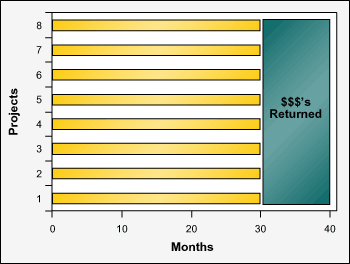
Look around your workspace. Is your in-box stuffed to overflowing? Do you have a long list of new emails that will take you days to get through? Is your voice mail rejecting new messages? Are people waiting for your work output?
All of those items represent “work in process,” also called “things in progress” (TIP). This is work that someone else – a co-worker or a customer – has requested of you, and they are awaiting your action. One of the core principles of Lean Six Sigma is that you have to reduce TIP if you want to stand a chance of delivering work faster and reducing waste in your processes.
The secret to reducing TIP is found in a rule known as Little’s Law:
![]()
This equation is a lot more important than it may look at first. The equation tells an organization that it can speed up lead time – deliver work faster – only by reducing the number of things in process or by speeding up the completion rate (how quickly work gets done).
Most people already work about as fast as they can, so making any significant gains in completion rate is unlikely (unless the company wants to hire a lot more staff, which is unlikely).
Reducing Number of “Things in Process”
That leaves “reducing the number of things in process.” How can a company reduce TIP and improve speed? By setting up what is known as a “pull system.” The essence of a pull system is that work enters a process at the same rate at which it exits. Since the “exit rate” is controlled by customer demand, that means the process is paced to meet the customers’ needs.
Here is an example. A business loan department that was responsible for providing quotes to customers was unhappy with the performance of one of the supporting departments. It often took the other department two to three weeks to develop the information that the business loan unit needed to complete its quotes. The customers wanted their quotes within three days.
A team collected data during a period of a few weeks that showed the evaluators in the supporting department could process an average of 20 quotes per day. In order to reliably meet a three-day turnaround schedule, the evaluators would actually have to aim for a target closer to 2.4 days. In that way, even the normal amount of variation in the process would not push the turnaround beyond three days.
How many “things” could the evaluators allow in the process? They turned to Little’s Law and plugged 20 into the completion rate and 2.4 days into lead time, to come up with a maximum TIP of 48 quotes in process at any time:
![]()
Determining this cap on the amount of work in process is the key element in a pull system. The next step is creating an input buffer or bin. The bin can be a physical compartment or an electronic database, depending on the nature of the work. Requests in the buffer are not officially in the process.
Creating Your Own Pull System
If you would like to try creating a pull system in your work area, here’s a suggested sequence of steps:
- Identify/confirm the service level you want to achieve. (Ask your customers what service level they want.)
- Determine your work group’s completion rate (based on data).
- Use Little’s Law to determine the maximum amount of work requests (“things in process”) you can have active at any given time.
- Cap the active work in the process at the maximum amount of work in process.
- Put all incoming work into an input buffer.
- Develop a triage system for determining which incoming work should be released into the process next.
- Continue with other process improvements so you can improve completion rate and further reduce lead time.
One into the Process When One Exits the Process
The only trigger for releasing work into the process is having an item exit the process – and that is what a pull system is. In this case, as long as there were 48 orders already in process, no work could exit the buffer. The guaranteed service level of a two-and-a-half-day turnaround would not start until the request entered the process.
The third element of a pull system is a system for deciding which work should be released out of the buffer.
In this case, the question was which request would be released next into the process when an “in process” request was completed. “First in, first out” did not cut it here because some requests represented highly likely, high-dollar-potential loans while others were much less likely to be accepted, represented uncertain situations, or were for smaller loans.
The answer lay in triaging the quote opportunities. Each request was rated on a scale of 1 to 3 on each of three criteria:
- Difficulty to complete the quote
- Competitive advantage
- Dollars of gross profit
The scores for each criteria were added together for each opportunity. Those with the highest scores would be the next to be released into the process – even if there were other bid opportunities that had been waiting in line longer. In other words, a new request that scored a 9 would be released before an older request that scored a 6.
Here is the paradox that most people have a hard time believing: By reducing the amount of work in progress, the department sped up its lead time for nearly all bids (except those that scored very low and never made it out of the buffer). More importantly, using this system, the same number of staff were able to book 70 percent more revenue and 80 percent more gross profit.
Managing a Pipeline Project with Pull System
In most organizations today, the tendency is to push as many projects into a pipeline as possible. This is true whether the projects deal with customer requests, designing new services or products, or improving operations (with Black Belt projects, for instance). Pushing excess work into a process clogs the process and dramatically increases lead times.
Little’s Law applies here as well as anywhere. All that is needed is to substitute “projects in process” for “things in process.” For example, assume that an organization has 20 Black Belts, and that the average time it takes them to complete a project is four months (for a completion rate of one-quarter projects/month/Black Belt). But now the company has decided that it wants to get projects completed in an average of three months. What is the maximum number of projects that should be “in process” at any one time? Apply Little’s Law:
| Basic Little’s Law Equation |
Lead Time to Results (LT) = Number of Projects in Process (PIP) / Project Completion Rate (CR) |
| Solve for PIP | Maximum PIP to Maintain Lead Time = LT x CR |
| Plug in the Numbers | PIP = LT x CR = 3 Months x 5 = 15 Projects Per Month CR = Completion Rate Per Black Belt x Number of Black Belts = .25 Projects Per Month Per Black Belt x 20 Black Belts = 5 Projects Per Month |
With 20 Black Belts and only 15 projects, that means some projects will have two Black Belts assigned (or that there will be five “floaters” who go wherever they are needed). Intuitively, this equation makes sense: by doubling up one-fourth of your resources (five Black Belts), the company saves one-fourth of the original lead time, or one month.
If an organization has the opposite situation – more projects than Black Belts – it will have to develop a triaging system to decide which projects will be released in the process next. In most cases, factors like expected return, ease of implementation, and relevance to customer and/or strategic needs will carry the biggest weight in the decision.
In either case, the calculation is meant as a starting point only. The math will not work out this perfectly each time; thus a reality check to see if the figures make sense is a good idea. The company will need to closely monitor results to see if completion rates, lead time to results, etc. have been overestimated (or underestimated). Then adjustments should be made accordingly. But basically, knowing the number of Black Belts and making reasonable estimates of their average completion rate, an organization will be able to put a cap on the number of projects and prevent excess projects from clogging its Lean Six Sigma pipeline.
Avoiding a Clogged Six Sigma Pipeline
In the example used here, for instance, if a company wants to get a project completion rate of two months, then 10 projects is the maximum which can be in progress. Before another project is launched, one will have to be completed or scuttled. This discipline forces people to prioritize projects around business objectives and return on investment. Some detailed planning needs to be done to avoid competition for shared resources, but this first cut is a major step forward for a majority of companies.
The result makes intuitive sense on another level as well. A “lone wolf” Black Belt cannot possibly have all the skills and experience possessed by a complementary team. And experience shows there is greater risk of a project producing disappointing results when a team and its project have only a single Black Belt as opposed to those with multiple Black Belts. If the organization cannot afford to assign multiple Black Belts to a project, then it should be sure not to overload any individual Black Belt with too many projects. Developing Green Belts to the point where they can operate independently with Black Belt guidance is a good way to compensate.
Another benefit of using a pull system to reduce the number of projects in process is that the organization starts to reap the rewards much sooner. To illustrate: In a traditional approach (Figure 1), all projects start at once. Each of four resources split their time evenly between two projects. In the pull approach (Figure 2), all resources are focused on the two highest priority projects. Once those are accomplished the resources move on to next highest priority projects, and so on. The result is more is accomplished sooner.


The biggest barrier any organization faces is overcoming the notion that a clogged pipeline or in-box is a good sign. To the contrary, an efficient organization is one that knows how to focus its resources to improve cycle time and customer satisfaction.